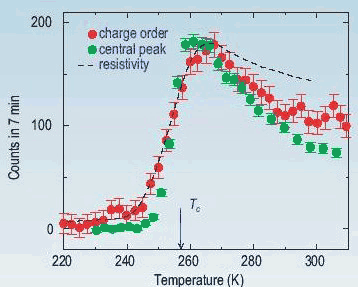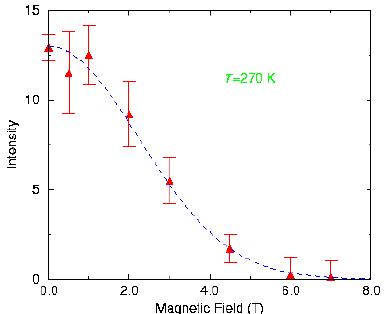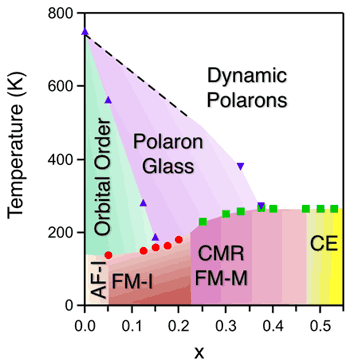Colossal Magnetoresistive Oxides
The magnetic properties of the lanthanum manganese oxide class of materials have attracted tremendous interest recently because of the dramatic increase in conductivity these systems exhibit when the magnetic moments order ferromagnetically, either by lowering the temperature or applying a magnetic field. This huge increase in the carrier mobility, which has been given the name "Colossal MagnetoResistivity" (CMR), is both of scientific and technological interest. In particular, it is anticipated that the "half-metallic" behavior these materials exhibit could provide fully spin polarized electrons for use in “spintronics” applications, for sensors in a variety of applications such as in the automotive industry, and may also provide the next generation of read/write heads for the magnetic data storage industry.
The CMR originates from a magnetically driven insulator-metal transition, where the magnetic, electronic, and structural degrees of freedom are intimately intertwined. Neutron scattering measurements have been used to discover that the transition from the low temperature ferromagnetic-metallic state to the paramagnetic-insulator state is caused by the formation of combined structural/magnetic polarons, which have a size of about one nanometer. The formation of these nanoscale polarons truncates the ferromagnetic phase, and thus explains the first-order nature of the transition. These polarons form a well defined thermodynamic glass phase above the ferromagnetic ordering temperature, which then melts into a polaron fluid at higher temperatures as shown in the figures below.
There is a strong similarity between these nanoscale polarons observed in the CMR materials, the polar nanoregions that cause the dramatic piezoelectric response of relaxor ferroelectrics, and the formation of stripes in the high temperature superconducting cuprates. Recent progress in our understanding of these intrinsic nanoscale structures has enabled a deeper understanding of the fundamental properties and shared concepts of all these perovskite-based materials.

"Polaron Mountains" shown on the left were discovered in the colossal magnetoresistive oxide materials. They "pop up" as we go from the metallic ferromagnetic state at low temperature to the paramagnetic polaron state at high temperatures, whereas a magnetic field suppresses the polarons. Thus the development of ferromagnetic order, either by lowering the temperature or increasing the magnetic field, is detrimental to polaron formation. The polarons are short range, ~ 1 nm, and purely elastic, so that the behavior is glass-like; a polaron glass
see Phys. Rev. Lett. 85, 3954 (2000) Phys. Rev. B 76, 014437 (2007).

Temperature and field dependence of the polarons, showing that they track the resistivity (after J. Appl. Phys. 81, 5488 (1997): Phys. Rev. Lett. 85, 3954 (2000))

To understand the structure and dynamics of this ferromagnetic-metallic to paramagnetic-insulating transition, as the paramagnetic state is entered the purely elastic component to the structural polaron scattering signals the development of the correlated polaron glass phase. This elastic scattering is accompanied by dynamic correlations that also peak at the same wave vector. The dynamic polaron correlation length in this phase is also around a nanometer. The strength of the elastic scattering diminishes with increasing temperature until the static polarons disappear at a higher temperature T*. The correlations remain above this temperature, but are then purely dynamic in character.

Schematic block phase diagram for La1-xCaxMnO3, where the proposed polaronic glass phase has been sketched and how it might evolve into the long-range ordered Jahn-Teller transition for the undoped compound. Basic ferromagnetic-metallic to paramagnetic-insulating, ferromagnetic-insulating to paramagnetic insulating, and antiferromagnetic to paramagnetic phase transitions are from previous work (see references given in Phys. Rev. B 76, 014437 (2007)).
Same additional references:
Phys. Rev. Lett. 76, 4046 (1996)
Phys. Rev. Lett. 85, 2553 (2000)
Phys. Rev.B70, 134414 (2004)
Phys. Rev. B70, 214424 (2004)
Phys. Rev. Lett. 93, 267204 (2004)
